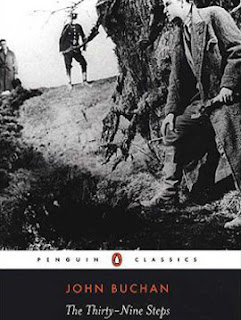People may say what they will about one of the most loved and loathed classic thrillers of the last century, but The Thirty-Nine Steps by John Buchan has proven its place after almost 100 years. Written around the outbreak of World War I and published in 1915 while Buchan was recuperating from a peptic ulcer, he set a new tone for espionage thrillers with a flair for high adventure.
His protagonist, Scotsman Richard Hannay, is an extremely capable Boer War veteran and rugged gentleman who has returned to London after making a small fortune in South Africa. As such, part of his charm is the exaggerated calm and melodrama in which he recounts an extraordinary tale.
Richard Hannay is bored before the outbreak of the First World War.
Like many self-made men, Hannay had always planned to find his fortune and then return home, enjoying his retirement as an affluent member of English society. What he never expected is that despite the cultural richness of London, he would quickly begin to miss the risk responsible for making him a rich and respected colonialist. In the short span of a few months, he is close to done with London.
But just as Hannay had given London a mere few more days to redeem itself and alleviate his boredom, he is besieged by American Franklin Scudder for help. Scudder, who reveals himself as man in fear for his life, claims to have faked his own death and asks Hannay take him in to avoid being found out.
 Although Hannay is unsure whether or not he should believe him, the unusual request is just enough to pique his interest with high hopes to be either exhilarated if it is truth or amused if it is not. In the days that follow, the evidence suggests that Scudder is telling the truth. But even if it didn't, the fourth day erases any doubt when Hannay returns to the flat to find the man stabbed in the heart.
Although Hannay is unsure whether or not he should believe him, the unusual request is just enough to pique his interest with high hopes to be either exhilarated if it is truth or amused if it is not. In the days that follow, the evidence suggests that Scudder is telling the truth. But even if it didn't, the fourth day erases any doubt when Hannay returns to the flat to find the man stabbed in the heart.Fearing that the police will pin him with murder and feeling a sense of duty to take on Scudder's assignment to foil an assassination on Greek Premier Constantine Karolides, Hannay invents an elaborate plan to flee the flat by masquerading as a milkman. Carrying nothing but Scudder's coded notebook and his wits, Hannay thrust himself headlong into the game of espionage and counterespionage (not unlike many stories told by filmmakers today).
With an apparent knack for finding ciphers, uncanny ability to adopt disguises, and considerable luck, Hannay attempts to stay one step ahead of his pursuers while searching for anyone willing to give him credibility and corroborate his story. And in the telling of it all, Buchan somehow manages to balance early pulp fiction with the sophistication of a gentleman, speeding through some scenes while drawing out suspense in others. Even Hannay himself veers back and forth between being invincibly tenacious and carelessly naive.
About the author John Buchan, 1st baron Tweedsmuir.
In some ways, Buchan isn't all that different from his dual life as a writer and political aficionado. After a brief legal career, the Scottish novelist served as a private secretary to the colonial administrator in Southern Africa and was later recruited to write propaganda for the British War Effort.
In some sense, Buchan epitomized the characterization of a rugged gentleman, even if he suggested once that Hannay was based in part on Field Marshall Edmund Ironside. Ironside spent some of his military career spying on German colonial forces in Africa before being identified and nearly caught.
Eventually, while maintaining his career as a novelist, Buchan's political and diplomatic career also flourished. He would eventually become governor general of Canada and encouraged Canada to develop its own identity and national unity. He wrote more than 100 works, including novels, biographies, historical books, short stories, and a collection of poems.
The Thirty-Nine Steps By John Buchan Jolts 8.0 On The Liquid Hip Richter Scale.
Although many people reading the Thirty-Nine Steps today might consider the character Richard Hannay a cliche, it's an unfair assessment given the opposite holds true. Hannay was the seminal characterization that would influence the countless spies who would follow in books and film. A much more fair criticism of Hannay in his first appearance would focus on how often the character finds himself at the right place at the right moment to move himself along.
Given the story is told in just over 200 pages, it's an excellent quick read that feels surprisingly timeless. The Thirty-Nine Steps by John Buchan has been added to the free digital books from Amazon, which also carries print editions from various publishers. Barnes & Noble also carries several print editions of the novel. You can also find The Thirty-Nine Steps for free on iBooks or enough the recent audiobook release on iTunes. It's read by B.J. Harrison, who delivers a classic narration fitting of Hannay himself.
While the novel was always well received, especially by men who actually read the story in the trenched of World War I, Alfred Hitchcock's 1935 adaption of The Thirty-Nine Steps remains a favorite, even if it greatly deviated from the original work by turning it into a romantic thriller. There is some cheese served alongside it, but Hitchcock's sharpness still shines through.
![Liquid [Hip]](https://blogger.googleusercontent.com/img/b/R29vZ2xl/AVvXsEjAFBQPqS7J0-rrttNoRYSsuwIePPZf4Nq6sqDioK1zzVQXJIQXKzq_NVNI4n6h3inuRQFBKOcJeZeSufkdHHIOxbSWyBjTjTxgKEQGyPzdwvkEEeECh4bI5YEGk4RWGUINSd7vulPQsCA/s1600-r/liquidhip.jpg)

